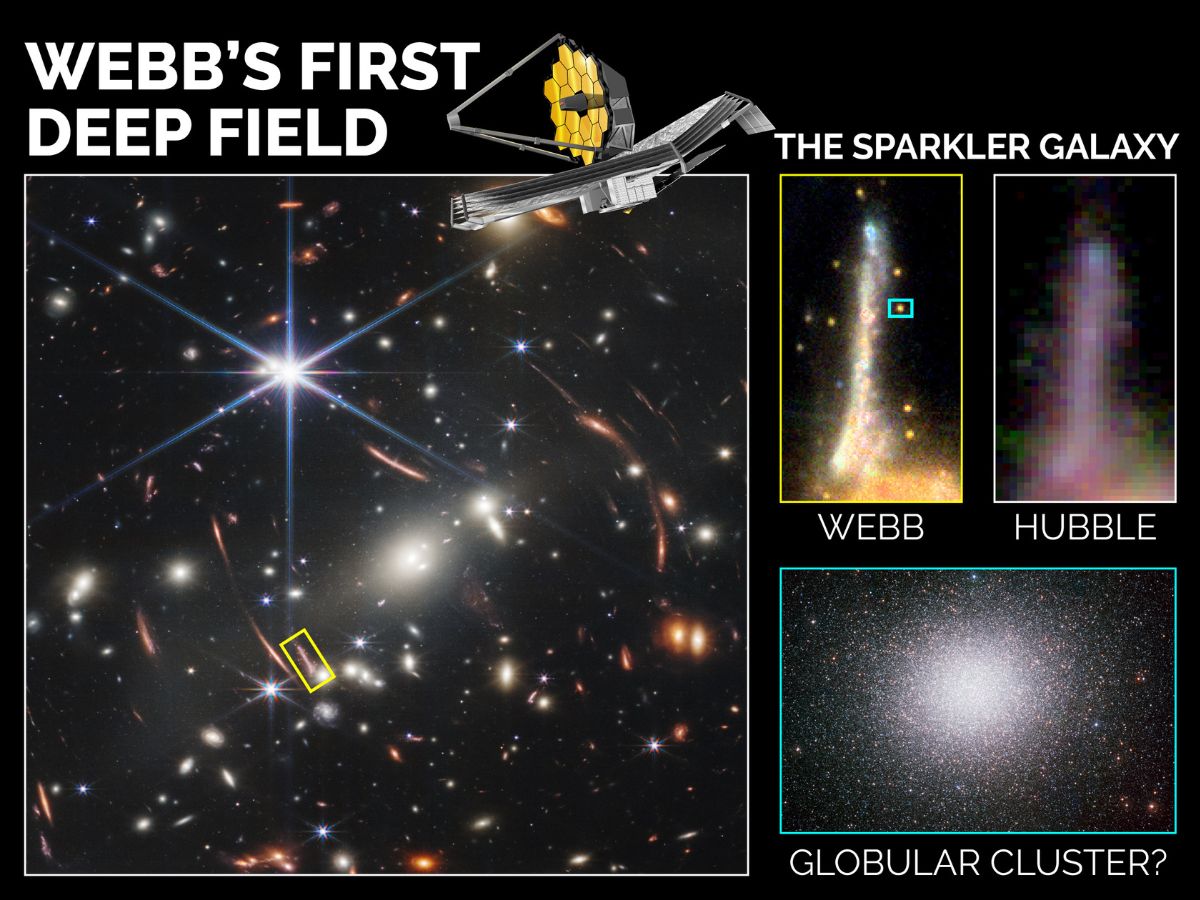Oldest Star Clusters In The Universe Identified Using James Webb Space Telescope. All You Need To Know
Small yellow-red dots surrounding the Sparkler galaxy, called sparkles, could either be young clusters actively forming stars, born three billion years after the Big Bang at the peak of star formation

NASA released the James Webb Space Telescope's (JWST's) first image in July, 2022. It was a picture of the galaxy cluster SMACS 0723, which harbours thousands of galaxies. Known as Webb's First Deep Field, the near-infrared, high resolution image reveals dense groups of millions of stars that may be relics containing the oldest stars in the universe. Using the JWST, a team of astronomers has identified the most distant globular star clusters ever discovered.
Webb's First Deep Field shows some of the universe's earliest galaxies. An early analysis of the image was published September 29 in The Astrophysical Journal.
In a statement released by University of Toronto, Lamiya Mowla, a co-lead author on the study, said JWST was built to find the first stars and the first galaxies and to help the world understand the origins of complexity in the universe, such as chemical elements and the building blocks of life.
She added that this discovery in Webb's First Deep Field is already providing a detailed look at the earliest phase of star formation, confirming the incredible power of JWST.
What is Sparkler Galaxy?
In Webb's First Deep Field, the astronomers zeroed in on what they have dubbed 'the Sparkler galaxy', which is nine billion light years away. The galaxy is called 'the Sparkler galaxy' because of the compact objects appearing as small yellow-red dots surrounding it. The researchers refer to these dots as 'sparkles'.
Oldest stars in the universe
These sparkles could either be young clusters actively forming stars, born three billion years after the Big Bang at the peak of star formation, the team posited. In other words, these stars are old globular clusters.
Globular clusters, which are ancient collections of stars from a galaxy's infancy, contain clues about its earliest phases of formation and growth.
Since Earth is just four-and-a-half billion years old, and the sparkler galaxy is nine billion light years away, it suggests that the stars surrounding it are the oldest in the universe.

The researchers initially conducted an analysis of 12 of these compact objects. They determined that five of these objects are not only globular clusters but among the oldest ones known.
Kartheik G Iyer, co-lead author on the paper, said that looking at the first images from JWST and discovering old globular clusters around distant galaxies was an incredible moment. This was not possible with previous Hubble Space Telescope Imaging, Iyer added.
He also said that since one could observe the sparkles across a range of wavelengths, they can also model the sparkles and better understand their physical properties. For instance, astronomers can determine how old they are and how many stars they contain. Using the JWST, globular clusters can be observed from great distances.
There are about 150 globular clusters in the Milky Way galaxy. However, it is not known how and when exactly these dense clumps of stars formed. It is very challenging to measure the ages of globular clusters. Age-dating the first stars in distant galaxies using very distant globular clusters had not been done before. It is only possible with the JWST.
Mowla said that these newly identified clusters were formed close to the first time it was even possible to form stars. Since the Sparkler galaxy is much farther away than the Milky Way, it is easier to determine the ages of its globular clusters, she added.
Gravitational lensing and JWST’s resolution made Sparkler galaxy very clear
Astronomers could not observe the surrounding compact objects of the Sparkler galaxy using the Hubble Space Telescope. The JWST's increased resolution and sensitivity changed this. The telescope unveiled the tiny dots surrounding the Sparkler galaxy for the first time in Webb's First Deep Field image.
The Sparkler galaxy is magnified by a factor of 100 due to an effect called gravitational lensing. This is what makes the Sparkler galaxy special. The SMACS 0723 galaxy cluster in the foreground distorts what is behind it, like a giant magnifying glass. Gravitational lensing produces three separate images of the Sparkler galaxy. This allows astronomers to study the galaxy in greater detail.
A gravitational lens can occur when a huge amount of matter, like a cluster of galaxies, creates a gravitational field that distorts and magnifies the light from distant galaxies which are behind it but in the same line of sight. The gravitational lensing effect is like looking through a giant magnifying glass.
CAnadian NIRISS Unbiased Cluster Survey (CANCUS) team lead Chris Willott said the study of the Sparkler highlights the tremendous power in combining the unique capabilities of JWST with the natural magnification afforded by gravitational lensing.
Webb’s instruments made important discoveries
The team combined new data from Webb's Near-Infrared Camera (NIRCam) with Hubble Space Telescope archival data. NIRCam uses longer and redder wavelengths to observe past what is visible to the human eye and even the Hubble Space Telescope, and to detect faint objects.
Observation of these compact objects has been possible because of magnifications caused by the gravitational lensing effect of the galaxy cluster and the high resolution of the JWST.
Webb's Canadian-made Near-Infrared Imager and Slitless Spectrograph (NIRISS) instruments provided independent confirmation that the objects are old globular clusters. This is because the team did not observe oxygen emission lines.
Oxygen emission lines are measurable spectra given off by young clusters that are actively forming stars. Using data from the NIRISS instrument, astronomers understood the geometry of the triply lensed images of the Sparkler galaxy.
Next, studies will be conducted to model the galaxy cluster under the lensing effect and to better understand star formation histories.
Related Video
Southern Rising Summit 2024: How Important is Self-Awareness? Insights from Anu Aacharya | ABP LIVE






































